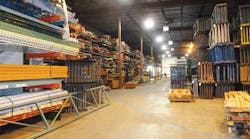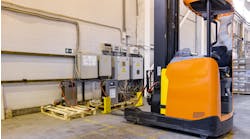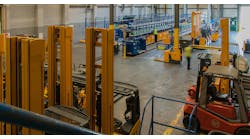As companies downsize, relocate, consolidate, or go out of business, pre-owned equipment enters the market. Much of it came from reputable mid to large-sized companies that engaged in strict preventative maintenance (PM) practices and kept the equipment in good condition. It represents an opportunity for small to mid-sized companies to purchase material handling and warehouse equipment at 40-60% off the price of new. Even large corporations with tight budgets can supplement operations with pre-owned equipment.
"I didn't want to pay a premium for all new rack, when high quality refurbished rack was well suited for the job,” says Sandro Guttilla, director of operations at E & S Foods Inc., a Whippany, N.J.-based wholesale grocery supplier for food distribution and food security services.
Guttilla recently faced a three-month deadline to get his renovated Whippany facility's racking, refrigeration and freezer equipment installed and operational. To do so he contacted American Surplus of Providence, R.I., a provider of used material handling equipment.
"They shipped the equipment to us early and handled installation so we finished the project five days early,” says Guttilla. "We moved into the facility faster, which kept productivity high and our customers happy.”
While the glut in pre-owned material handling and warehouse equipment has resulted in a buyer's market, the question is where to buy it?
There are wholesalers of pre-owned equipment that act as middlemen to "flip” or sell product they do not own. Typically, such middlemen sell equipment as they get it, find it as needed, or sell it from its original location without taking possession. In many cases, this equipment is sold sight unseen.
Often these middlemen are smaller "mom and pop”-type operations that lack the physical warehouse space or capital to take ownership of pre-owned equipment. Since delivery must be coordinated through a third party, it can delay delivery and add a "middleman mark up.”
Some larger operations warehouse a wider range of pre-owned equipment ready for delivery. They might also have enough capital to continue making equipment purchases from the many companies going out of business or facility locations being closed.
Another factor to consider is how the recent volatility of steel pricing can delay new equipment purchases. With recent steel prices fluctuating almost daily, in some cases equipment manufacturers are waiting for orders to be input into purchasing before they order steel. This delays the ability to manufacture and can extend lead times for new equipment by as long as eight weeks. Dealers with pre-owned equipment in stock, however, may be able to turn an order around in seven to ten days.
While the buyer's market for quality pre-owned material handling and warehouse equipment lasts, small, mid-sized, or even large operations can take advantage of it to boost their production capacity at lower prices.
Those that do so will be well positioned not only during the current economy, but also when the recovery ramps up.
"Since we've moved into the renovated building, sales have grown about 5% with our existing staff,” says Guttilla. "Our improved workflow saves us about three hours of labor per eight-hour shift. By making this happen in our renovated building instead of building a new facility from scratch, we saved about $300,000.”



